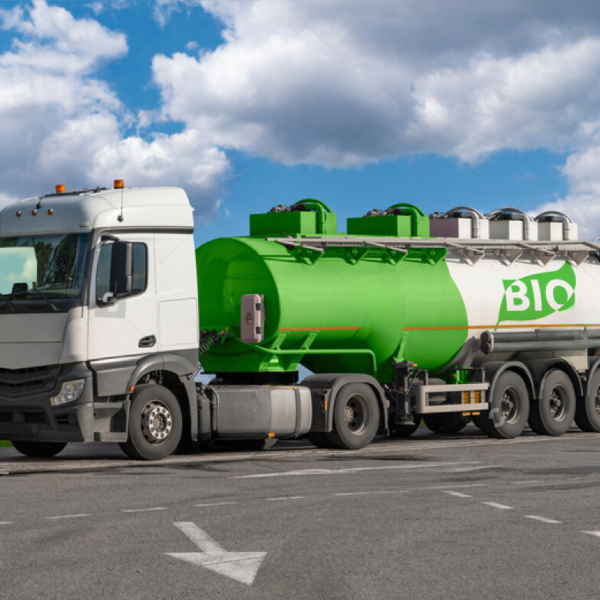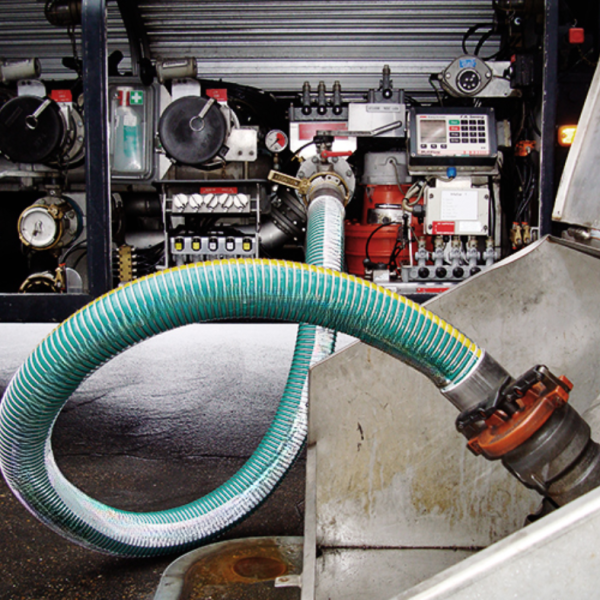Biofuel Transfer (Standard Duty & Heavy Duty)

Biofuel transfer composite hoses are specialized hoses designed for the safe and efficient transportation of biofuels, which are renewable energy sources derived from organic materials such as plant-based oils, fatty acids, ethanol, biodiesel and agricultural waste. These hoses are a crucial component in the biofuel industry, ensuring the smooth and secure transfer of these alternative fuels from one point to another, whether within a processing facility, during transportation, or during fuelling operations.
Compliance : Biofuel Transfer hoses are manufactured in accordance to EN 13765 / 2018 Type 2 & Type 3



Construction
- Hose Type - GNG, SNG
- Inner wire - Galvanised Steel / Stainless Steel 304, 316
- Inner Lining - Polyamide films, fabric & barrier layers
- Outer wire -Galvanised Steel / Stainless Steel 304, 316
- Cover -Abrasion-resistant PVC impregnated fabric
- End fitting - As per client requirements, externally crimped and swaged
Features
- Polyamide fabric provides for maximum resistance to biofuel.
- Strongly bonded inner and outer wires helps to achieve maximum Electrical continuity.
- Tough PVC outer cover resists dragging, wearing, abrasion, UV and ozone resistance ensures maximum durability and safety.
- Choice of Galvanised, Stainless-Steel or Polypropylene coated inner wire can be provided.
- Suitable for 0.9 Bar Vacuum rating
- Working Pressure: 10 Bar (150 PSI) (Standard Duty) & 14 Bar (200 PSI) (Heavy Duty)
- Safety factor 4:1 as per EN 13765 / 2018 (can be achieved higher if required)
- Temperature Range for this hose is -30° C to +100° C (-22° F to +212° F)
Applications
Fuel Truck Loading and Unloading: Biofuel transfer hoses are used in fuel distribution networks and at retail fuel stations to transfer various types of biofuels, including ethanol, biodiesel, and other renewable fuels, from storage tanks to dispensers.
Transportation: In the transportation industry, these hoses are used to load and unload biofuels onto tanker trucks, railcars, and ships. The flexibility of composite hoses makes them ideal for connecting between different points, even in tight spaces or when dealing with changing angles.
Bioenergy Production Plants: Facilities that produce bioenergy, such as biogas or bioethanol plants, require the transfer of biofuels within their processes. Composite hoses are employed to move biofuels between different stages of production and storage.
Renewable Energy Installations: Composite hoses are used to transfer biofuels in renewable energy installations, such as biogas plants or biomass power generation facilities, where biofuels are converted into energy through combustion or other processes.
Marine and Offshore Applications: Biofuel transfer hoses are used in marine and offshore industries for transferring biofuels between vessels, platforms, and terminals, where resistance to harsh sea conditions and durability are crucial.
Specification Table : Type 2
| CODE | SIZE | MEAN OD | MAX W.P | MIN BURST | BEND RADIUS | WEIGHT (KG) | MAX LENGTH | |||||||
| NAME | MM | INCH | MM | BAR | PSI | BAR | PSI | MM | INCH | GG & SG | MT | FT | ||
| 03S6G25 | 25 | 1” | 37 | 10 | 150 | 40 | 600 | 125 | 5 | 1.00 | 30 | 100 | ||
| 03S6G38 | 38 | 1.5” | 50 | 10 | 150 | 40 | 600 | 150 | 6 | 1.35 | 30 | 100 | ||
| 03S6G50 | 50 | 2” | 65 | 10 | 150 | 40 | 600 | 200 | 8 | 1.50 | 30 | 100 | ||
| 03S6G65 | 65 | 2.5” | 76 | 10 | 150 | 40 | 600 | 200 | 8 | 1.70 | 30 | 100 | ||
| 03S6G75 | 75 | 3” | 89 | 10 | 150 | 40 | 600 | 300 | 12 | 2.40 | 30 | 100 | ||
| 03S6G100 | 100 | 4” | 119 | 10 | 150 | 40 | 600 | 400 | 16 | 3.70 | 30 | 100 | ||
| 03S6G150 | 150 | 6” | 178 | 10 | 150 | 40 | 600 | 575 | 23 | 8.60 | 30 | 100 | ||
| 03S6G200 | 200 | 8” | 231 | 10 | 150 | 40 | 600 | 800 | 32 | 14.60 | 30 | 100 | ||
*Higher burst pressure can be achieved on special request
Specification Table : Type 3
| CODE | SIZE | MEAN OD | MAX W.P | MIN BURST | BEND RADIUS | WEIGHT (KG) | MAX LENGTH | |||||||
| NAME | MM | INCH | MM | BAR | PSI | BAR | PSI | MM | INCH | GG & SG | MT | FT | ||
| 03HS6G25 | 25 | 1” | 37 | 14 | 200 | 56 | 800 | 200 | 8 | 1.00 | 30 | 100 | ||
| 03HS6G38 | 38 | 1.5” | 51 | 14 | 200 | 56 | 800 | 200 | 8 | 1.35 | 30 | 100 | ||
| 03HS6G50 | 50 | 2” | 65 | 14 | 200 | 56 | 800 | 225 | 9 | 1.50 | 30 | 100 | ||
| 03HS6G65 | 65 | 2.5” | 77 | 14 | 200 | 56 | 800 | 225 | 9 | 2.10 | 30 | 100 | ||
| 03HS6G75 | 75 | 3” | 90 | 14 | 200 | 56 | 800 | 350 | 14 | 3.00 | 30 | 100 | ||
| 03HS6G100 | 100 | 4” | 121 | 14 | 200 | 56 | 800 | 400 | 16 | 5.60 | 30 | 100 | ||
| 03HS6G150 | 150 | 6” | 179 | 14 | 200 | 56 | 800 | 575 | 23 | 11.00 | 30 | 100 | ||
| 03HS6G200 | 200 | 8” | 233 | 14 | 200 | 56 | 800 | 800 | 32 | 16.40 | 30 | 100 | ||
| 03HS6G250 | 250 | 10” | 284 | 14 | 200 | 56 | 800 | 1000 | 40 | 21.30 | 15 | 50 | ||
| 03HS6G300 | 300 | 12” | 333 | 14 | 200 | 56 | 800 | 1200 | 48 | 26.70 | 15 | 50 | ||
*Higher burst pressure can be achieved on special request
Safety Standards
Rigorous Safety Testing
COMPOHOSE assemblies undergo comprehensive testing, conducted at 1.5 times the rated Working Pressure (W.P). This stringent testing adheres to the EN 13765 standard, ensuring a paramount level of safety and reliability.
Provision of Manufacturer's Test Certificate
With each supply of COMPOHOSE composite hose assemblies, a Manufacturer's Test Certificate is included. This certificate serves as a confirmation of the product's quality and compliance with safety standards, providing added assurance to users.
Clear Burst Pressure Specification
The burst pressure of the composite hose is explicitly indicated for ambient temperature conditions. This vital information enhances safety awareness and empowers users to operate within secure pressure limits.
Effective Electrical Continuity
The composite hose's electrical continuity is assured through the integration of two bonded wires connected to the end fitting. This innovative design promotes the dissipation of accumulated electrical charges, mitigating the risk of static flashes and associated hazards.



